
In the rigorous realm of Gearbox for Water and Wastewater , industrial gearboxes are pivotal for power transmission, enabling essential equipment to perform reliably under harsh conditions such as continuous operation, high torque, abrasive sludge, humidity, and chemical exposure. The water and wastewater industry, in particular, depends heavily on these gearboxes for critical processes ranging from agitation and aeration to sludge handling, clarifying, and pumping. This SEO-optimized, in-depth guide explores various types of industrial gearboxes in water & wastewater applications, their technical configurations, advantages, and performance aspects. While we will cover a broad range of gearbox types—including planetary, helical, bevel, worm, spur, cycloidal, and more—planetary gearboxes (also known as epicyclic or solar gearboxes) excel in this sector due to their unmatched torque density, compact design, and corrosion resistance. If you are seeking insights on industrial gearboxes for wastewater treatment, gearbox types for agitators or clarifiers, or guidance on selecting the best gearbox for water treatment facilities, this article delivers technical depth, practical insights, and real-world recommendations to help optimize your equipment for dependable operation.
By understanding the specific strengths of different industrial gearbox types, water treatment professionals can improve energy efficiency, ensure uninterrupted performance, and achieve substantial cost savings in demanding environments such as aeration basins, clarifier systems, or sludge dewatering lines. Drawing upon standards such as ISO 6336 for gear load evaluation, we highlight how correctly configured gearboxes contribute to sustainability, operational reliability, and long service life. As a leading solution for water & wastewater applications, the planetary gearbox continues to stand out as the top choice for high-performance, corrosion-resistant, and energy-efficient drive systems — and this guide will explain exactly why it should be a priority in your specification process.
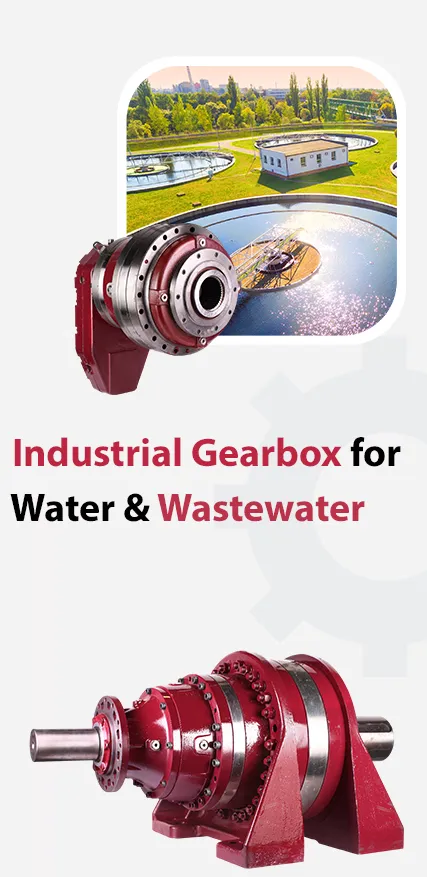

Industrial Gearbox for Water and Wastewater Applications come in several configurations, each serving precise duties within treatment plants.
Planetary Gearboxes: Deliver very high torque in compact footprints—perfect for clarifiers, aerators, and mixers.
Helical Gearboxes: Smooth, efficient power transmission for continuous pumps and agitators.
Bevel Gearboxes: Redirect power efficiently, ideal for inclined or vertical installations.
Worm Gearboxes: Provide high reduction ratios with self‑locking safety for bridge and scraper drives.
Spur Gearboxes: Simple, economical choice for presses, conveyors, and screens.
Cycloidal Gearboxes: Precise and shock‑resistant, used in dosing and aeration equipment.
Other Types: Hypoid or parallel‑shaft gearboxes handle special motion or load demands.
Among these, planetary gearboxes stand out for combining maximum torque density, long life, and corrosion‑proof operation under harsh, humid conditions.
Compact by design, planetary gearboxes consist of a central sun gear, surrounding planet gears, and an internal ring gear. This multi‑gear load sharing enables up to 10:1 per stage and more than 1000:1 in compound setups, offering powerful torque within minimal space.
Click here to view our planetary gearbox products and their technical information.
With efficiencies around 95–98% and robust seals that resist moisture and chemical exposure, they operate smoothly from ‑25 °C to +90 °C in submerged or exposed environments.
Manufacturers such as SEAWIDE and Bonfiglioli supply modular designs capable of absorbing shock loads up to 5× rated torque, making them exceptionally reliable for continuous duty.
Beyond technical performance, planetary gearboxes also offer a strong economic and operational advantage for treatment facilities. Their modular architecture simplifies maintenance, allowing rapid part replacement without dismantling the full system—minimizing downtime and service costs. Integrated monitoring features enable predictive diagnostics, helping operators schedule lubrication and load checks proactively. Combined with their efficiency and compact form, this smart, service‑friendly design gives wastewater plants up to 30% lower lifecycle cost compared to conventional drives, while maintaining continuous operation under the most demanding environmental conditions.
Beyond performance ratings, planetary gearboxes provide tangible lifecycle advantages for treatment utilities. Their modular structure enables quick servicing without disassembling connected shafts, cutting downtime and labor costs. Integrated sensors allow real‑time temperature and vibration monitoring, supporting predictive maintenance strategies that extend equipment life by up to 40%.
Combined with high efficiency, corrosion‑resistant materials, and adaptive smart‑service options, these gearboxes deliver up to 30% lower total ownership cost compared to conventional helical or worm drives—while sustaining round‑the‑clock reliability across critical water and wastewater operations.
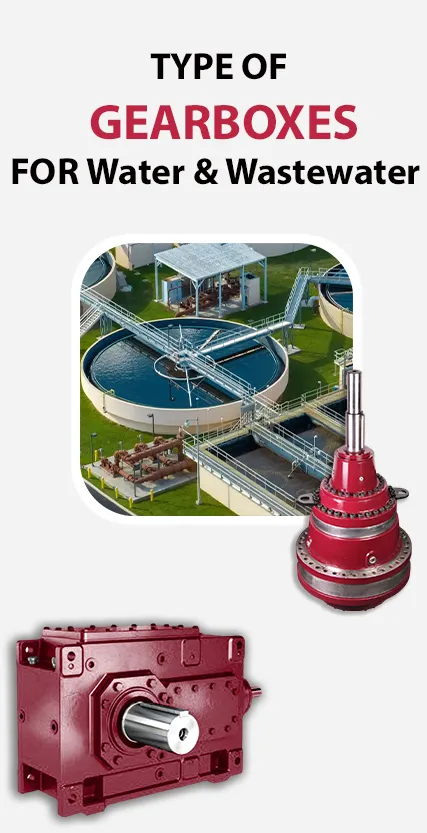
Helical gearboxes, with angled teeth (15–30°), ensure smooth power flow and quiet operation through gradual engagement. Components include shafts, gears, bearings, and housings, supporting ratios up to 100:1 and torque up to 500,000 Nm. Efficiency: 90–95%; operating range –10 °C to +60 °C.
Advantages: Reliable load capacity, low vibration (<75 dB), versatility, and simple maintenance.
Applications: Aerators (steady torque drive), pumps (continuous duty), agitators (high load mixing), conveyors, and sludge thickeners. While dependable, they take more space than planetary units and show slightly lower efficiency.
Planetary gearboxes use a central sun gear, orbiting planet gears, and an outer ring gear to deliver extremely high torque density in a compact housing. This configuration evenly distributes load and minimizes backlash, ideal for continuous operation in humid or submerged environments. Torque range: up to 1,200,000 Nm with efficiency > 95%.
Advantages: High torque / weight ratio, compact footprint, shock‑load resistance, and superior positioning accuracy.
Applications: Clarifiers (slow, high‑torque rotation), sludge mixers (variable torque), aeration systems, screw conveyors, and decanter centrifuges. Though costlier than helical units, planetary gearboxes provide unmatched durability and efficiency in critical W&W processes.
Bevel gearboxes use conical gears to change drive angle by 90°, providing ratios up to 6:1, torque to 100,000 Nm, and 90–92% efficiency.
Advantages: Compact for angular or vertical drives, durable in wet and gritty settings.
Applications: Bridge scrapers, clarifiers, and vertical mixers needing directional power change. Reliable but less adaptable for very high torque where planetary types perform better.
Worm gearboxes contain a screw‑like worm engaging a wheel, achieving high reductions (up to 100:1) with self‑locking action. Torque: 50,000 Nm; efficiency: 50–90%.
Advantages: Compact footprint, stable operation, and safety from back‑driving.
Applications: Sludge conveyors, skimmers, gate drives, and slow‑speed agitators.
Drawbacks include reduced efficiency and heat buildup under continuous duty compared to planetary gearboxes.
Spur Gearboxes in Water & Wastewater
Spur gearboxes employ straight‑cut teeth for power transfer between parallel shafts. Ratios up to 10:1, torque 200,000 Nm, efficiency 94–98%.
Advantages: Simple design, low cost, and easy servicing.
Applications: Small pumps, bar screens, compact conveyors, and dosing devices. They are noisier and less refined than helical or planetary types but practical for low‑to‑medium loads.
Cycloidal Gearboxes in Water & Wastewater
Cycloidal gearboxes use eccentric cams for high reduction (up to 100:1) and torque to 500,000 Nm with 90–95% efficiency.
Advantages: Shock absorption, precision motion, and high overload tolerance.
Applications: Aeration systems with variable speed, dosing pumps, and automated valves. Effective but more expensive than planetary units, which deliver similar torque density.
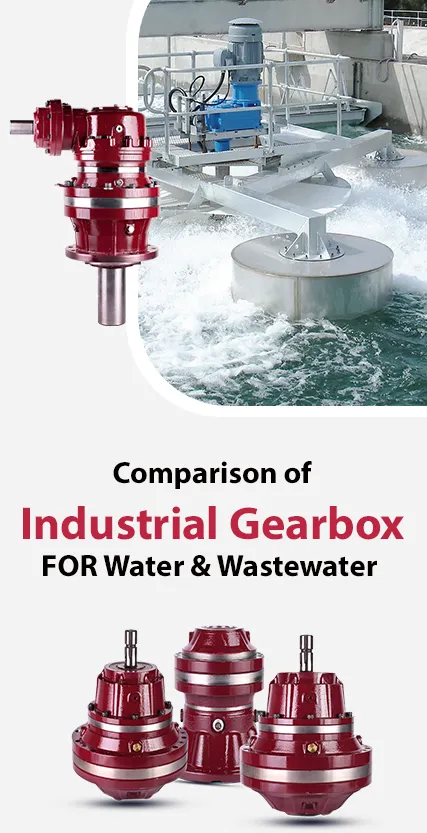
| Gearbox Type | Torque (Max Nm) | Efficiency | Compactness | Best W&W Use | Key Limitation |
|---|---|---|---|---|---|
| Planetary | 1,000,000 | >95% | High | High‑torque, space‑limited drives (aerators, mixers) | Higher cost |
| Helical | 500,000 | 90–95% | Moderate | Versatile loads (pumps, conveyors, agitators) | Larger size |
| Bevel | 100,000 | 90–92% | High | Angled drives (clarifiers, skimmer bridges) | Limited ratios |
| Worm | 50,000 | 50–90% | High | Self‑locking (sludge conveyors, gates) | Low efficiency |
| Spur | 200,000 | 94–98% | Low | Basic equipment (small pumps, bar screens) | Noisy |
| Cycloidal | 500,000 | 90–95% | High | Shock‑resistant drives (aeration, dosing units) | Costly |
Key Water & Wastewater Machinery: Detailed Introductions, Optimal Gearbox Recommendations, and Selection Considerations
In the water and wastewater industry, a wide range of specialized equipment is essential for continuous treatment, conveyance, and processing of fluids and sludge. Each unit operates under constant load, humidity, and corrosive conditions, requiring durable power transmission systems such as industrial gearboxes to maintain reliability and performance. Below, we introduce key W&W machinery one by one, outlining functions, the most suitable gearbox types (with strong focus on planetary gearboxes for their high torque density, compact design, and superior sealing), gearbox characteristics, and vital considerations for proper gearbox selection. This section extends our detailed guide to industrial gearboxes in water & wastewater applications, offering practical insights for engineers seeking to maximize equipment lifespan and energy efficiency. By emphasizing planetary gearboxes—recognized for >95% efficiency, multi‑stage options up to 10:1 per stage, and capacity to absorb shock loads up to 5× nominal torque—we reinforce their position as the leading solution for demanding operations involving aeration, agitation, and sludge treatment in modern water facilities.
In water and wastewater treatment facilities, each mechanical stage—from aeration and clarification to sludge handling—relies on precise and durable power transmission. Industrial gearboxes translate motor energy into controlled rotational force, enabling continuous movement, mixing, or conveying even under high moisture, chemical exposure, and variable loads.
Understanding how gearboxes integrate with each process step is essential: the torque, speed, and sealing requirements differ across equipment types. The sections below outline the key machinery used in W&W applications and illustrate how the right gearbox selection enhances system reliability, efficiency, and lifecycle economy.
Aeration systems are core devices in biological treatment plants that introduce oxygen into activated-sludge basins, supporting microbial degradation of organic matter. Surface and submersible aerators use gearboxes to regulate rotational speed, ensuring energy-efficient oxygen transfer and continuous mixing. Rugged housing and precise speed control preserve aeration efficiency under variable hydraulic loads and water levels.
Optimal Gearbox Type: Helical or Planetary gearbox — suitable for surface and low-speed rotating aerators that demand smooth power and precise speed adjustment under 24/7 duty.
Features of the Device: Impeller diameters up to 3 m, motor power ranges of 15 to 90 kW, stainless structure with anti-corrosive coating, floating or bridge-mounted designs for varied basin types. Adjustable blades maximize oxygen diffusion.
Features of the Gearbox: Gear ratios 10:1 to 25:1, torque output to 200,000 Nm, high-efficiency (>95%) gearing with reinforced bearings and dual lip seals (IP68 rated). VFD integration enables variable-speed operation.
Selection Considerations: Assess aeration load and basin depth for correct torque selection; ensure gear alignment to impeller shaft; specify marine-grade materials for corrosive atmospheres; confirm compatibility with control systems.
Equipped with helical or planetary gearboxes, aeration units offer stable oxygen delivery, 30% lower energy consumption, and longer service life — crucial for continuous biological treatment efficiency.
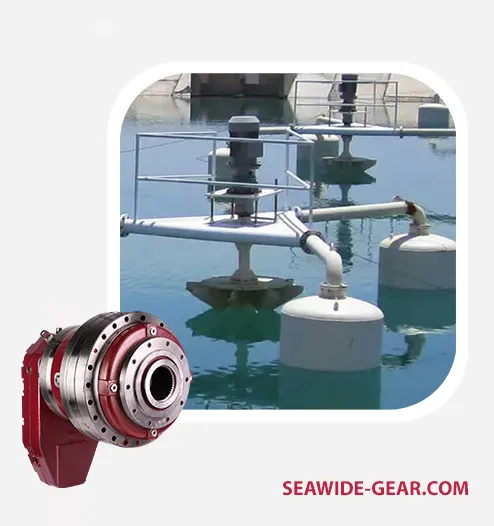
Clarifier and scraper bridge systems play a vital role in solid-liquid separation by rotating arms that collect settled sludge or skim surface scum in circular settling tanks. They operate under slow, steady motion with high torque demands at low rpm. Planetary gearboxes ensure balanced torque transmission and smooth rotation without shock loading, allowing continuous clarification.
Optimal Gearbox Type: Planetary gearbox — ideal for center-drive and peripheral bridge mechanisms that demand uniform load distribution and high output torque.
Features of the Device: Span diameters up to 60 m, drive torque 20,000–150,000 Nm, high-precision bearings, rake arms in stainless steel, automatic sludge discharge valves, and integrated torque limiters for safety.
Features of the Gearbox: Torque capability up to 250,000 Nm, gear ratios up to 30:1, hardened alloy gears, sealed oil-bath lubrication, and anti-condensation systems. Allows smooth start-stop cycles and electronic torque monitoring.
Selection Considerations: Base selection on rake diameter and sediment load; ensure planetary gear alignment with central pier structure; apply corrosion-resistant materials and environmental sealing.
Planetary drives in clarifiers improve system reliability, prevent overload failures, and extend service life in continuous settling applications.
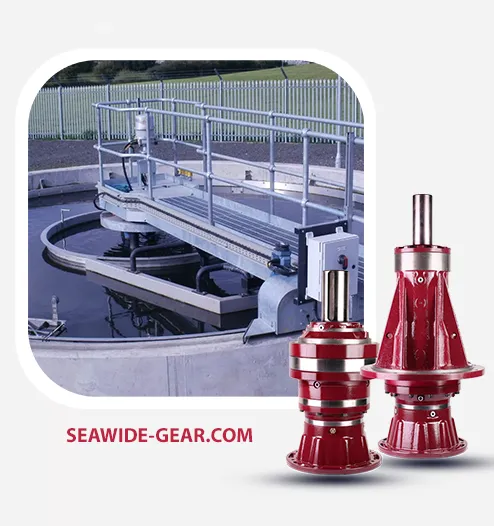
Sludge thickeners and dewatering units concentrate solids to reduce water content before disposal or reuse. Rotating discs or drums require steady torque and low speed to handle fibrous and viscous materials. Helical or cycloidal gearboxes provide robust, efficient motion with smooth acceleration for drum and belt operations.
Click here to view our Industrail Gearbox products and their technical information.Optimal Gearbox Type: Helical or cycloidal gearbox — preferred for low-speed drives handling continuous sludge loads.
Features of the Device: Variable speed drives, friction-resistant drums in SS316 material, sludge entry control valves, automatic wash systems, motors up to 200 HP, drying belt mechanisms, and torque load sensors.
Features of the Gearbox: Ratios up to 60:1, efficiency >92%, torque range up to 150,000 Nm, cast iron or stainless casings, thermal-compensation seals, and auto-lubrication systems for wet conditions.
Selection Considerations: Evaluate solids content and sludge viscosity to match the gear ratio; ensure shock-load resistance; specify gearboxes with oil drains and anti-leak design for rotary press or belt applications.
High-efficiency gearboxes in thickening systems cut power use, increase torque stability, and enhance equipment uptime by up to 30%.
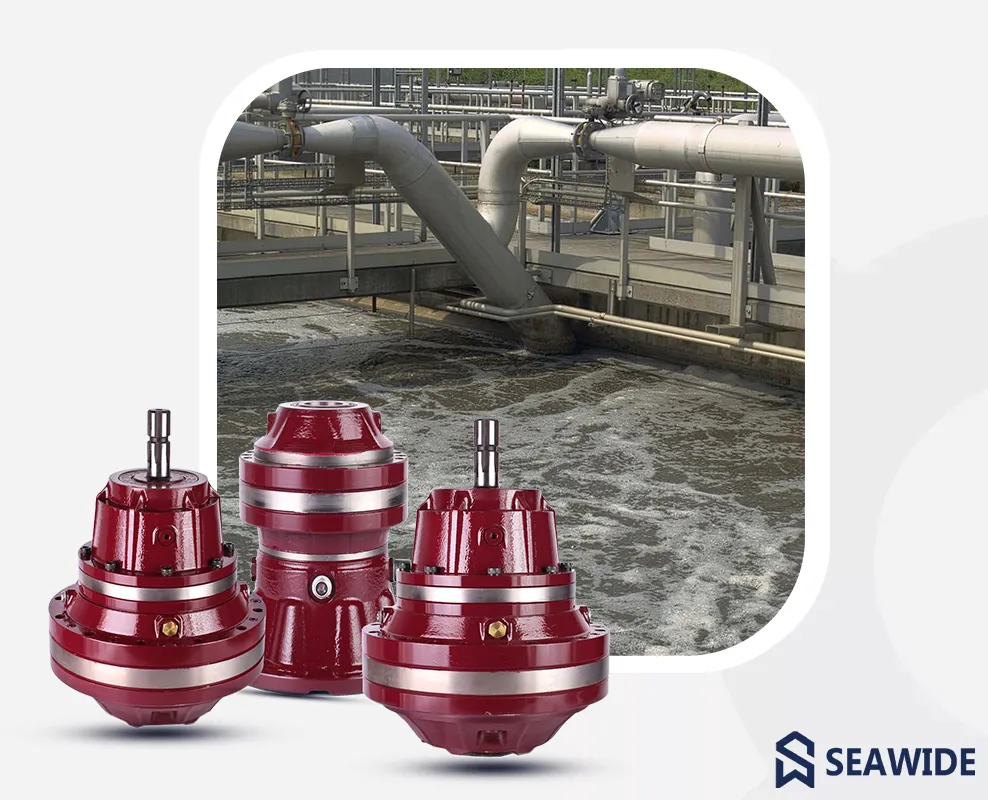
Sludge transfer trucks and mobile haulers are specially designed vehicles used to transport thickened biosolids from treatment plants to disposal or reuse sites. They utilize planetary transmissions and power-take-off gear systems for propulsion and pump actuation to handle dense slurries up to 1.3 t/m³.
Optimal Gearbox Type: Planetary gearbox — for axle and hydraulic drive arrangements requiring high torque in confined assembly space.
Features of the Device: Stainless storage tanks (30–40 tons), hydraulic discharge pumps, vacuum-assisted loading, four-wheel drive chassis with sealed transmission, PLC monitoring, and GPS tracking for route optimization.
Features of the Gearbox: Compact planetary sets with ratios from 15:1–25:1, high shock endurance, sealed oil chambers, and heat-treated gears for longevity. Power split arrangement enables simultaneous movement and pumping action.
Selection Considerations: Assess vehicle load and gradient; confirm transmission torque compatibility with engine output; use corrosion-proof coatings for sludge environments.
Planetary gear transmissions enhance traction and reduce fuel consumption by up to 25%, enabling reliable long-distance biosolid transport operations.
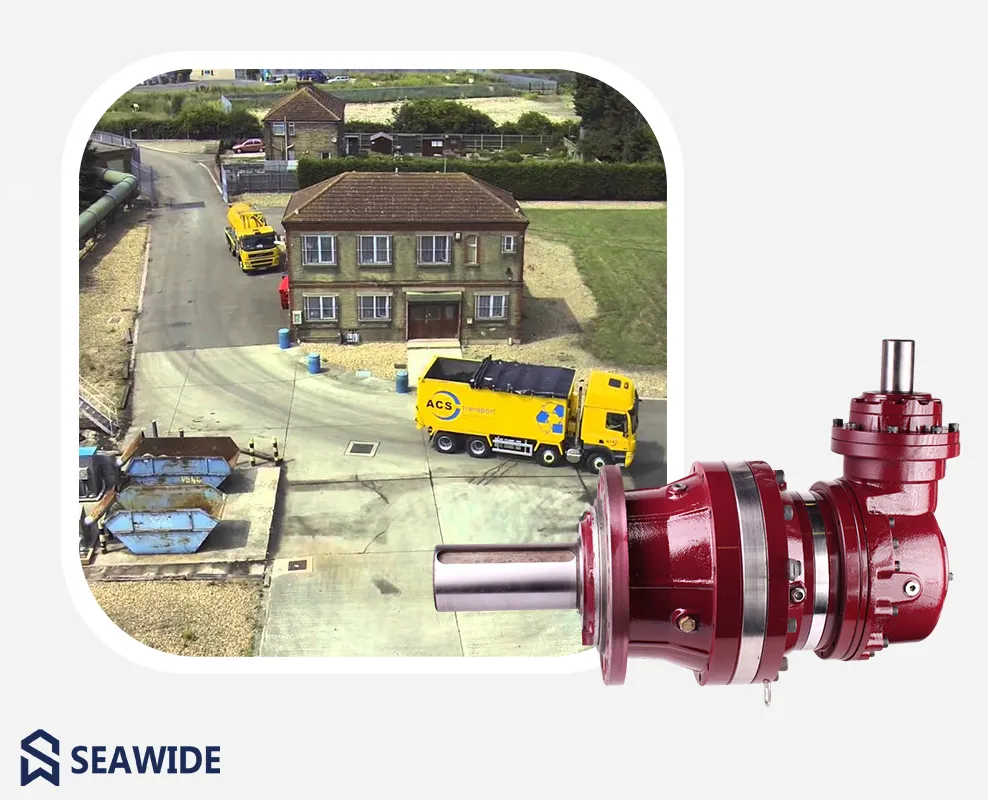
Grit classifiers remove abrasive particles such as sand and gravel from wastewater. They operate continuously under wet, corrosive, and highly abrasive conditions. Rake and screw systems require heavy torque at very low speed to convey dense mineral matter without slippage.
Optimal Gearbox Type: Planetary gearbox — best for rake drives and auger mechanisms that need precisely controlled low-speed rotation under abrasive load.
Features of the Device: Inclined tanks with spiral blades, motors up to 50 kW, rake arms with polyurethane scrapers, wash systems, and stainless components for extended durability.
Features of the Gearbox: Ratios up to 20:1, torque up to 300,000 Nm, hardened steel gears, sealed gear housing, and anti-wear coating for abrasion. Integrated hydrostatic drive enables speed adjustment under varying loads.
Selection Considerations: Check grit particle density and required torque; use gearboxes with anti-corrosion treatments and PLC compatibility; optimize drainage setup to keep bearings dry.
Planetary gear units in grit classifiers enable consistent material conveyance and reduce maintenance by more than 30%.
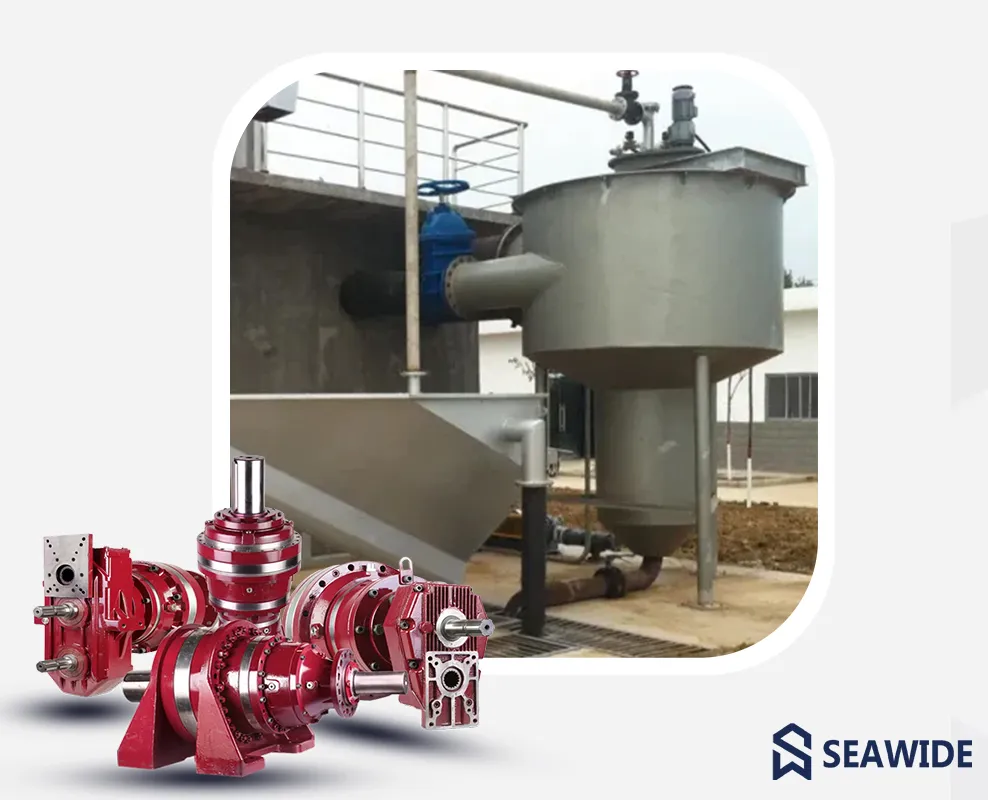
Screw and belt conveyors transport sludge, screenings, and grit from one process stage to another within treatment plants. These machines run continuously under variable loads and require reliable gear reducers for smooth, controlled movement of bulk materials.
Optimal Gearbox Type: Helical-worm gearbox — perfect for space-constrained installations needing a compact structure and high torque at low speed.
Features of the Device: Screw diameters up to 1 m, belt widths up to 2 m, variable speed motors, stainless troughs, removable covers, and load-controlled feeders.
Features of the Gearbox: Ratios up to 100:1, self-locking mechanisms, efficiency 90–93%, low-noise gearing, and IP66-rated housing. High-load bearings reduce friction loss.
Selection Considerations: Evaluate flow rate and density of material; select gear size to maintain optimal fill factor; use coated gear surfaces for protection against moisture and chemical attack.
Helical-worm drives in conveyors achieve stable motion, reduce energy demand, and extend service intervals for bulk sludge transport.
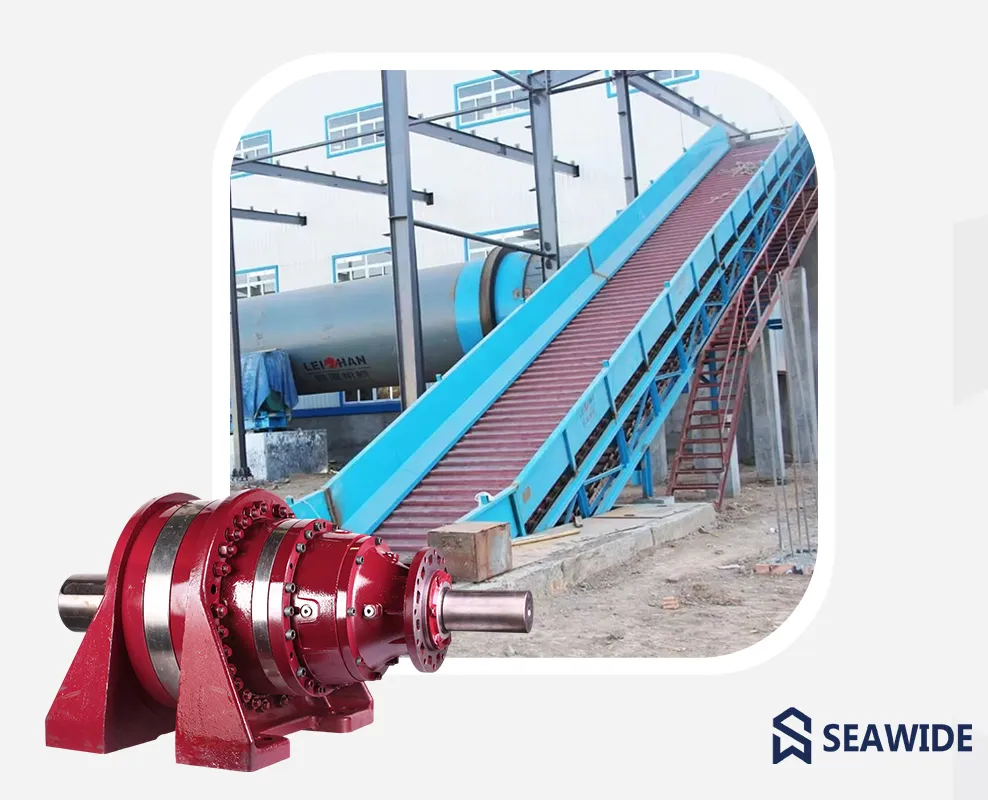
Decanter centrifuges separate solids from liquids using high-speed rotation and differential drives between bowl and scroll. Gearboxes manage speed differences of up to 80 rpm at bowl speeds exceeding 4000 rpm, requiring high precision and load balance.
Optimal Gearbox Type: Cycloidal or planetary differential gearbox — specially designed for high-speed synchronization and torque transmission with minimal vibration.
Features of the Device: Dual-motor drive, stainless centrifuge housing, automatic feed systems, and dynamic balancing for stable operation. Optional torque sensors monitor solid load.
Features of the Gearbox: Compact design with ratios up to 120:1, torque capacity up to 50,000 Nm, precision-ground gears, and oil-bath cooling system for continuous high-speed performance.
Selection Considerations: Identify solids loading and required differential speed; choose gearboxes with precise backlash control and temperature monitoring; ensure balanced mounting for minimal vibration.
Differential planetary gearboxes in centrifuges offer consistent separation efficiency, quiet operation, and extended bearing life essential for advanced wastewater dewatering lines.
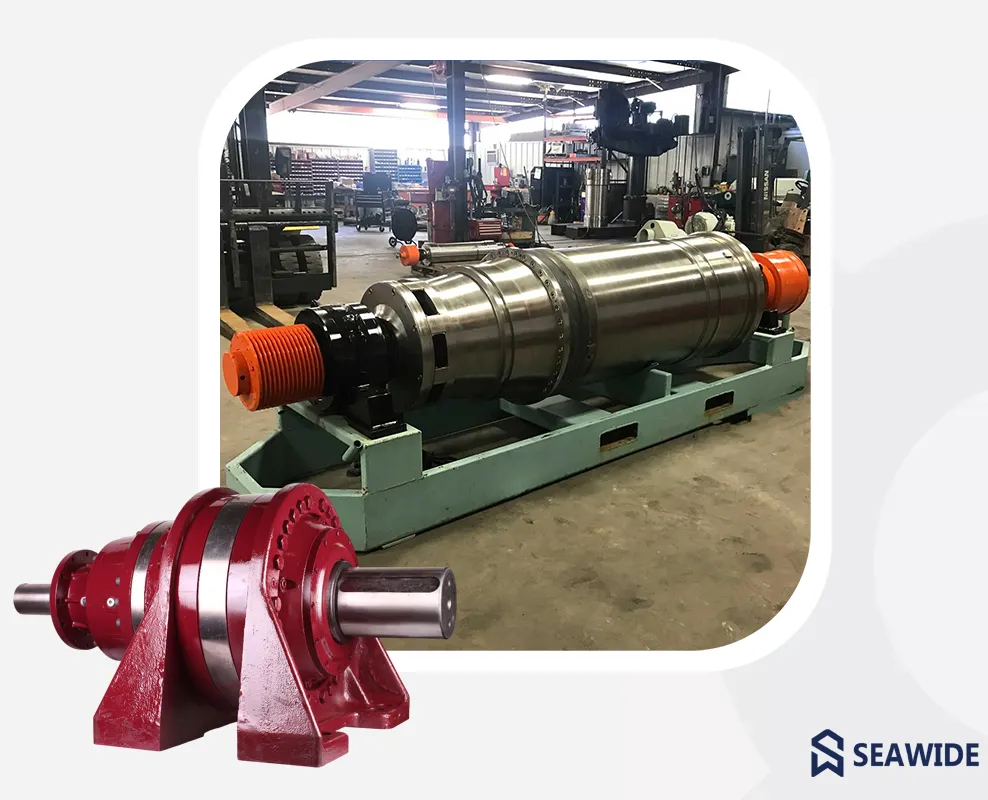
Planetary gearboxes are preferred for wastewater systems because they deliver high torque in compact size and operate reliably under continuous load and wet, corrosive conditions.
High-efficiency gearing (>95%) reduces motor load and energy consumption by 20–30%, especially in mixers, aerators, and clarifier drives that operate 24/7
Not directly. W&W applications require special sealings, anti-corrosive housing, and IP66-IP68 protection to resist moisture, chemicals, and abrasive particles.
Typical service interval is every 6–12 months for oil inspection and seal replacement; high-grade planetary gearboxes double that interval under proper lubrication
They deliver up to 3x more torque per unit volume, handle shock loads better, and need less space—making them ideal for mixers and clarifiers with limited installation area.
Humidity, chemical vapors, and grit can shorten gearbox life; using anti-corrosion coatings and double-labyrinth seals extends operational life by 40% or more.
Look for gearboxes compliant with ISO 9001, AGMA 6005, and IEC IP66/68 ratings; these ensure long-term safety and efficiency in wet environments.
